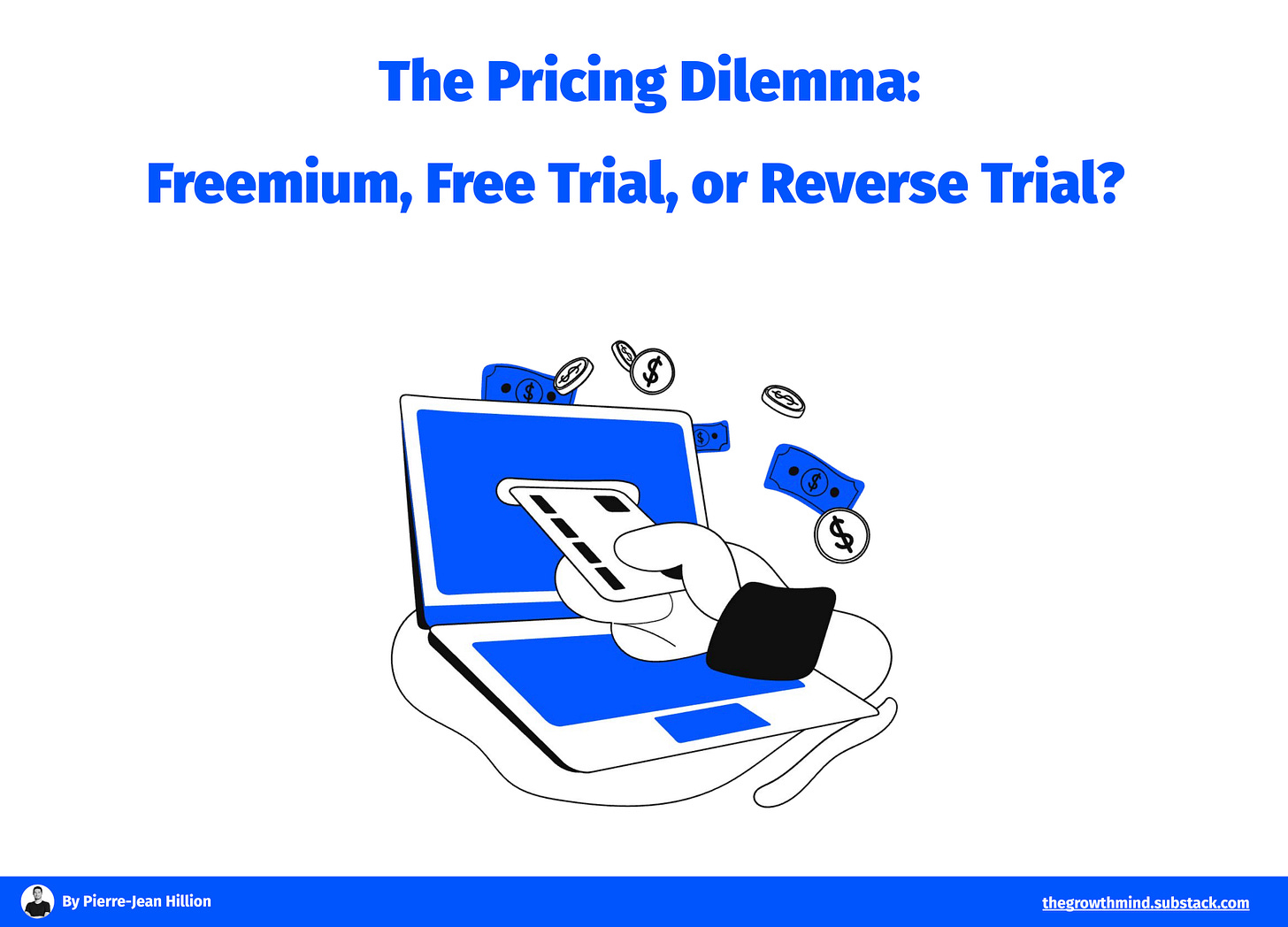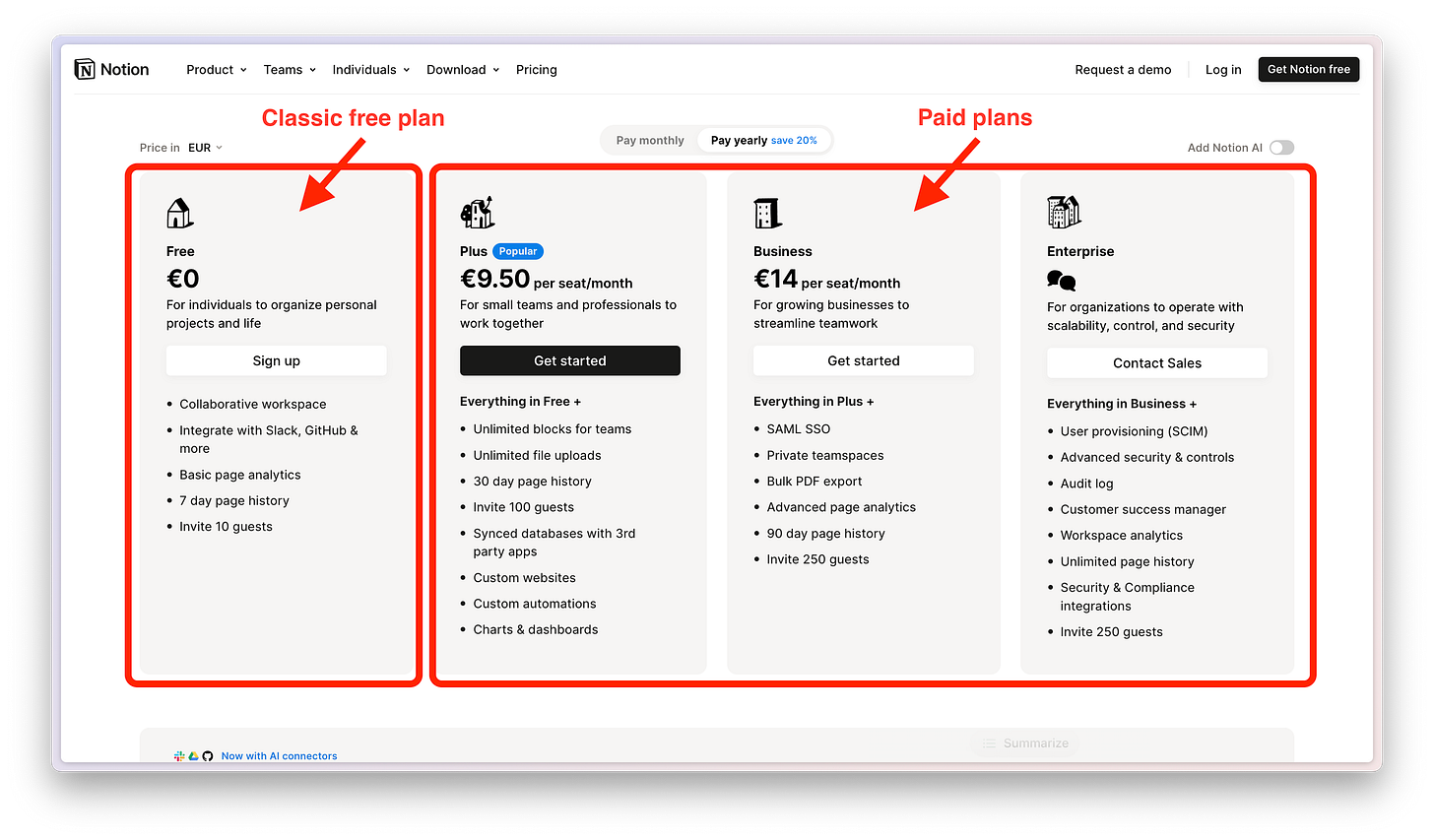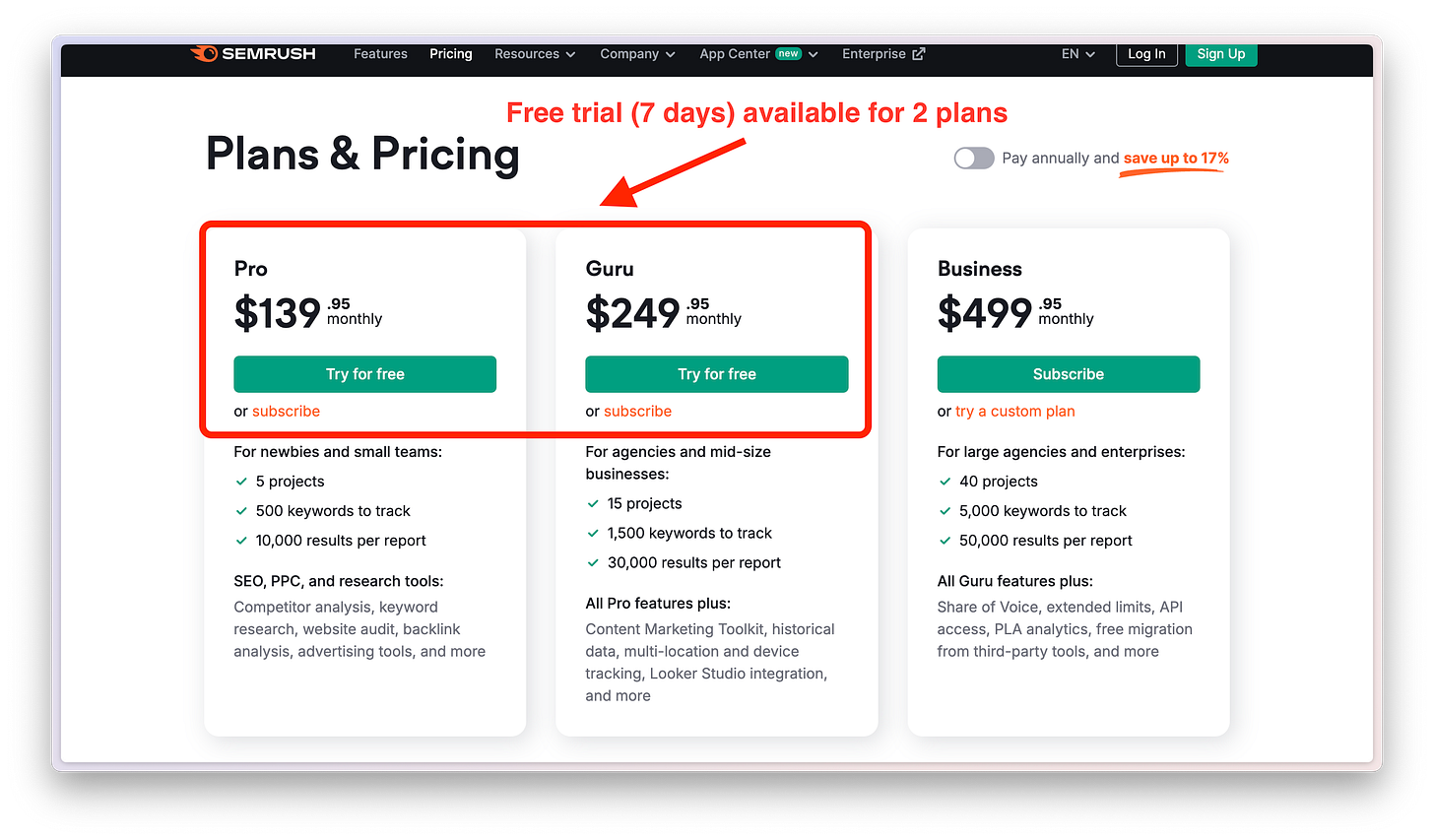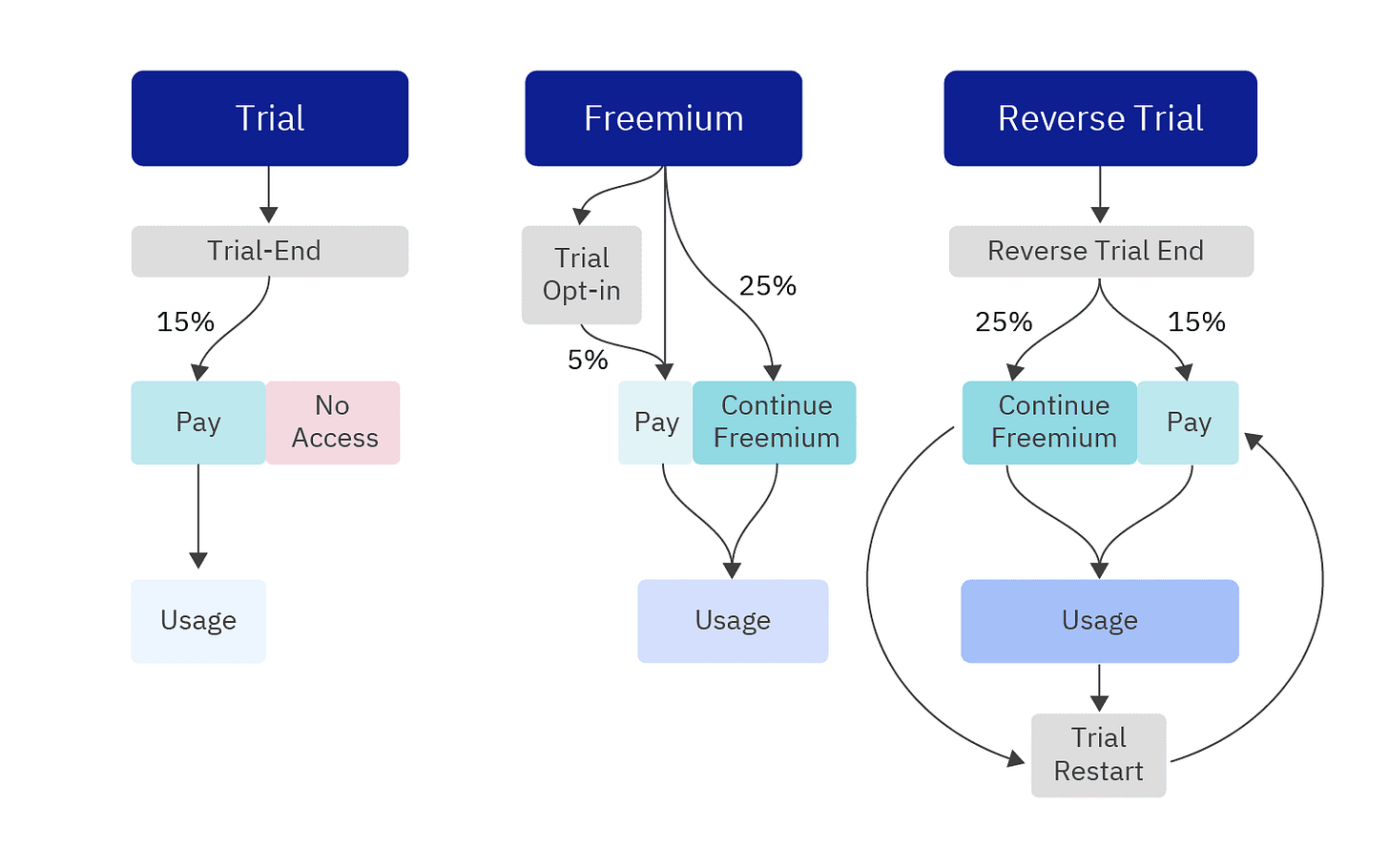The Pricing Dilemma: Freemium, Free Trial, or Reverse Trial?
How to choose, test, and optimize your pricing model for growth.
Hey, Pierre-Jean here 👋 Welcome to this new edition of The Growth Mind! Each week, I share deep-dive Growth strategies, playbooks, and case studies from the best scale-ups.
For more: Best of The Growth Mind | Work with me
Your pricing model can be your biggest growth lever or your biggest revenue killer.
Yet, many companies default to Freemium or Free Trial without truly testing their impact, leading to missed opportunities and sometimes big strategy mistakes.
So, how do you make the right call?
In today’s edition, we deep dive into:
The 3 pricing models (Freemium, Free Trial & Reverse Trial) for subscription businesses
How to choose the right one for your product
How to properly test and validate your pricing model
⏱️ Reading time → 5 minutes.
Let’s dive in!
1. The 3 pricing models for subscription businesses: Freemium, Free Trial & Reverse trial
A/ Freemium → Focus on acquisition & virality
In a freemium model, users can access a limited range of product features for free, without any time limit. They can decide to upgrade to a paid plan but also can stay on the free version forever.
→ Examples: Notion, Dropbox, Slack
B/ Free Trial → Focus on activation & monetization
In a free trial model, users can fully access your product (or at least one of the paid subscription tiers) during a limited time; generally 7, 14, or 30 days.
Once the trial period ends, they need to upgrade if they want to continue using the product.
There are two types of free trials:
Opt-in free trial: You don’t need to add a credit card to try the product (lower friction, but lower conversion from trial to paid).
Opt-out free trial: You need to add your credit card, and you will be charged at the end of the trial if you don’t unsubscribe (higher friction, but higher conversion from trial to paid).
→ Examples: Semrush, Shopify, Lemlist
C/ Reverse Trial → Hybrid approach
This is the combination of Freemium and Free Trial models.
Users start their journey by being put on a paid plan of the product, as it would be for a free trial. Once the trial ends, instead of being obligated to pay to continue using the product, they are downgraded to a free plan.
→ Examples: Calendly, Airtable, Canva
Here’s a visual summary of how each model works:
2. What’s the best pricing model for your business?
Spoiler: It depends. There is no one-size-fits-all answer. Each model has pros and cons and might better suit some businesses than others.
Your choice depends on four key factors 👇
🎯 Business objectives: What are you optimizing for?
Freemium is great if you need massive top-of-funnel adoption. You trade immediate revenue for upper funnel volumes.
Free Trial is great when you want to maximize activation/monetization. It’s important however to have a short time to value.
Reverse Trial is great if retention & usage are key. It encourages users to experience the premium value before deciding to pay.
🔍 Industry/competition: What are users expecting?
Follow the market → If all competitors use Freemium, a Free Trial might feel too restrictive, pushing potential users away.
Differentiate with pricing → On the other hand, pricing is also a way to differentiate. Having a freemium product in an industry dominated by short free trials might be a great move to boost acquisition.
💰 Cost structure: Can you afford a large free user base?
Low-cost structure → Freemium or Free Trial can work.
High-cost structure → A Free Trial is safer. Freemium means supporting a lot of users bringing no revenue.
🔦 Product type: Is your product easy to understand, or does it require in-depth usage?
Freemium works well if users can quickly understand and see value from the product (e.g., Loom) and network effects are important for product growth (e.g., Slack).
Free Trial works well if users need to experience the full version of the product to understand its value (e.g., analytics tools like Amplitude).
Reverse Trial works well if the premium version provides an obvious “aha moment” early on (e.g., Grammarly) and downgrading to free plan creates strong FOMO, pushing users to upgrade.
It’s always a trade-off, and there’s no perfect model:
📈 Freemium → More users, lower conversion
💰 Free Trial → Higher conversion, but no free users after trial
⚖️ Reverse Trial → Balanced approach, keeps free users & monetizes better than Freemium
Ask yourself:
Do I want to maximize reach or revenue?
Can I afford a large base of free users?
Do users immediately get value, or do they need time?
3. How to test your pricing model
Testing a pricing model is generally far more complex than doing a simple A/B test. It impacts positioning, network effects, and revenue. So it’s the kind of big bet having long-term consequences you need to prepare carefully.
❓ Step 1: Define why you’re testing
What’s the problem you’re trying to solve?
Is your free-to-paid conversion too low compared to the industry average?
Are you struggling with acquisition and need a low-friction top-of-the-funnel?
Are you trying to increase expansion revenue?
What’s the hypothesis behind choosing a new model?
Are you switching to freemium to drive mass adoption?
Are you testing free trial because users need to experience full product value before converting?
Are you trying reverse trial to improve retention and monetization?
→ A pricing model should ALWAYS be linked to the company vision and growth strategy.
📊 Step 2: Set the right success metrics
Think in terms of absolute numbers rather than pure conversion rates
Instead of just looking at Free-to-Paid Conversion Rate, focus on:
Total number of monetized users (not just conversion %)
Average revenue per user (ARPU)
Revenue impact over time (MRR, LTV)
A free trial might double conversion rates, but if signups drop by 60%, you’re actually loosing money.
🔭 Step 3: Adopt a full-funnel approach
Your pricing model impacts the entire funnel, not just free-to-paid conversion. Measure the impact of pricing on:
Signups: Does the new model increase or decrease acquisition?
Activation: Are users engaging differently before converting?
Free-to-paid conversion: What’s the % of users upgrading?
Retention: Do users stay longer in the paid plan?
Expansion: Are users upgrading or adding more seats?
🧪 Step 4: Set up a proper testing methodology
The worst thing that can happen in a growth experiment is to have unclear or biased results. It means you just lost precious time and resources for a test which is not making you learn anything. Pricing impacts multiple parts of the business (acquisition, monetization, retention), and a poorly designed test can lead to misleading conclusions and costly mistakes.
Work closely with data scientists and engineers: Pricing changes often involve complex technical implementation (billing systems, paywalls, user flows). Engineers help ensure the test is feasible and doesn’t break core product logic. Data scientists help structure the experiment correctly, ensuring results are statistically significant and free from bias.
Use cohort analysis: Compare user behavior before and after pricing changes to assess long-term impact.
Start with a controlled A/B test: Instead of rolling out wide, begin with a small subset of users to minimize risks (assuming you have enough volume to make the test significant). You can gradually expand if everything is going well.
⏳ Step 5: Measure long-term effects, not just quick wins
Some pricing models can drive short-term revenue uplifts but hurt retention and acquisition in the long run.
For example, a free trial can generate more paid users, but if they cancel after 1 month, the test is misleading.
That’s why you need to measure performance on key metrics over several months:
Churn rate after upgrade (Are they sticking around?)
Expansion revenue (Upsells, additional seats?)
Overall LTV (Do new users generate more revenue over time?)
🧭 Step 6: Keep it simple. Never test more than 2 models at once.
Testing two models can already be quite hard, so don’t add complexity. Too many variables will kill the clarity you want in your results.
Key takeaways of this edition:
There’s no perfect pricing model, only trade-offs between acquisition, conversion, and retention.
A pricing model can work for one product, but not for another. Competition, product type, and cost structure are all influencing which model is right for you.
Freemium drives mass adoption but converts less, Free Trial boosts monetization but limits reach, and Reverse Trial balances both but risks post-trial churn.
The key is to align pricing with the company's business strategy, measure absolute revenue impact (not just conversion rates), and test methodically to avoid costly mistakes.
Thanks for reading The Growth Mind! Subscribe for free to receive new posts and support my work.
Want to work together? Here are 3 ways I can help you:
Fractional growth lead: I act as your part-time growth lead to design and execute scalable full-funnel strategies. Perfect for startups needing senior-level expertise without committing to a full-time hire.
Growth workshop: A 3-hour workshop to co-create your growth roadmap, align product & marketing teams, and set up a culture of experimentation. Perfect for a deep review of your growth engine.
Growth power hour: In-depth, 1-hour sessions to diagnose your growth challenges and provide actionable recommendations across acquisition, activation, retention, and monetization.









Good stuff thanks
Super hands-on checklist when it comes to pricing, nice article!